This second blog in the Tomorrow War series explores the current methods of controlling quelea bird swarms and where they fall short. It makes a strong case to explore emerging technologies for their sustainable control.
The Tomorrow War - Controlling Quelea Swarms and Ultimately Africa's Future
November 8, 2022
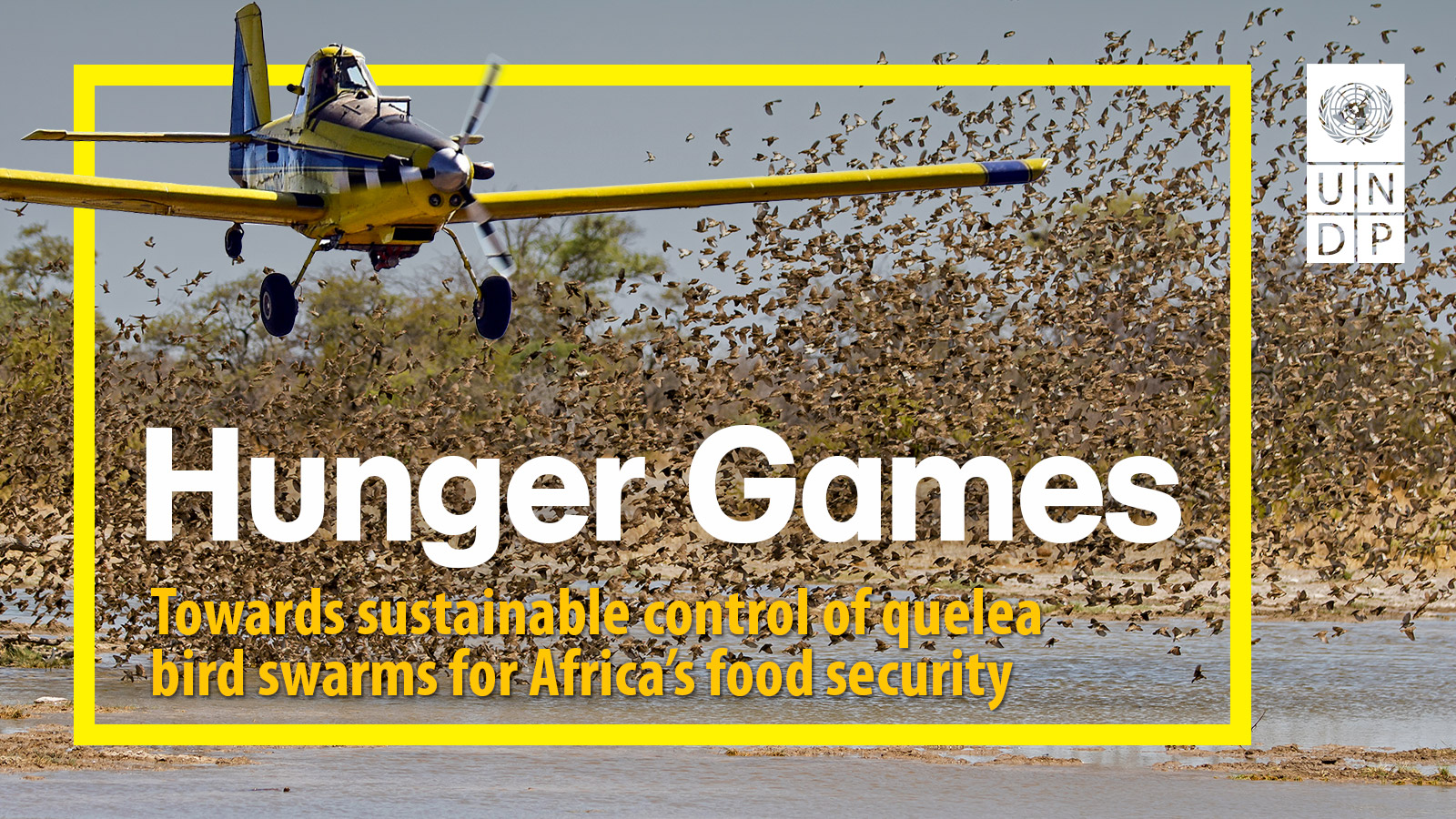
This is the 2nd blog in the Tomorrow War series. If you missed it, read the 1st blog of the series here:
The tomorrow war - Climate change, hunger, and swarming pests
Quelea breeding and roosting sites
Two important facts about the tiny bird’s roosting and breeding habits are important in understanding current and potential control methods.
First, quelea birds make their breeding ground in thorny bushes. A typical roosting site can cover tens of square kilometres. Each tree is covered by hundreds, sometimes thousands, of nests hanging weighing it down. In Zimbabwe this type of habitat is predominantly in the Zambezi and Save Valley region of the country. These two valleys form vast lands rich in flora and fauna, which as a result means they are predominantly national parks.
Second and very critical is the highly reproductive nature of the bird. A breeding pair can lay and hatch up to three quelea chicks, three times a year. So, if a female can produce up to nine chicks annually, imagine what a million-bird quelea swarm can grow to between agriculture seasons. Some swarms have been estimated to reach 30-million birds or more. You get the idea.
Control of quelea birds
Over the years, various methods have been implemented to minimize the impact of the quelea bird. These can be grouped into two main categories based on the magnitude of deployment - small scale traditional methods and modern large-scale methods.
Traditional methods of control

Buckets of dead quelea birds collected for consumption
Catch and consume
Quelea birds have been a source of protein for communities since 1950s. The birds are harvested as chicks by raiding breeding sites or as adults by using various rudimentary trapping methods. When harvested in bulk the excess can be sold to generate income. Travellers passing through quelea regions can get a pack of 15 roasted birds for $US1 from roadside vendors.
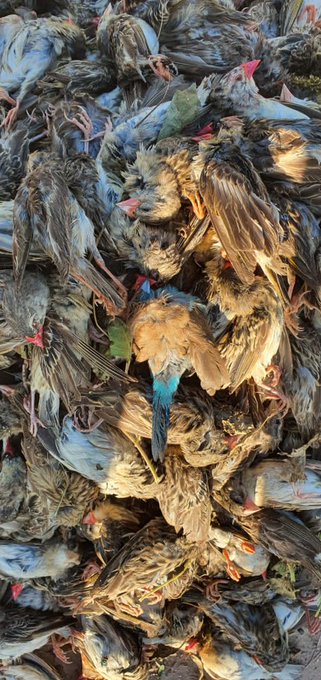
Scare tactics
Farmers have also attempted to control quelea birds by chasing or scaring them away from their fields. People are deployed to guard the fields and routinely generate loud sounds to scare the birds away. Alternatively, scarecrows in the form of brightly coloured plastics on sticks are placed across the grain fields.
More grain, less loss
Farmers in the same community have also cooperated to plant the same type of grain. When a swarm of birds descends on an area, it will spread across the region and eat from many fields. Though not a method of controlling the quelea birds themselves, it helps minimise the loss that would have been faced by a single farmer.
So why not just eat or scare them all?
Good question. These traditional control techniques were only effective when dealing with smaller swarms.
In the last decades, the size of the quelea bird swarm have become larger as a result of two factors. First, the expansion of farming land has depleted native annual grasses which the bird typically feeds on. As a result, they have turned to cultivated grain birds to go after cultivated grains.
At the same time, this increase in farming of grain means abundant food for the birds, which supports the rapid increase in the bird’s population. With an estimated population of at least 1.8 billion quelea birds in Africa, you can only eat and scare away so many birds.
In addition, these traditional methods pose three challenges which make them less ideal. First, as discussed at the beginning of this blog, the birds typically breed and roost in protected national parks. Harvesting the birds for consumption in these breeding sites, while more ideal, is considered poaching. A crime that attracts a jail term in Zimbabwe.
Second, as demand for food increases, quelea birds become daring and eventually realise that plastic and static scarecrows are non-lethal. Swarms have been observed to attack grain fields regardless of the presence of the scarecrows. This reinforces the need for human scaring.
However, and third, communal farmland is now located further away from dwelling villages because of growing population and increased demand for arable land. Scaring the birds is a continuous, labour-intensive activity that takes time away from other productive tasks. In the end, children end up taking this task and missing out on school.
Regardless of these challenges, consumption and scaring remain the most popular method to control the birds among rural farmers due to their near zero capital requirements. They are just not effective enough.
Large scale control
Given the severe impact of quelea swarms, 25 African governments that are mostly affected by the swarms have had to intervene and implement large scale control of the birds. While they have achieved some level of success of control, the control measures are not without their challenges, especially given the scale of operations.
Large scale control utilises various techniques to kill the birds at night when the birds are gathered in the roosting sites.
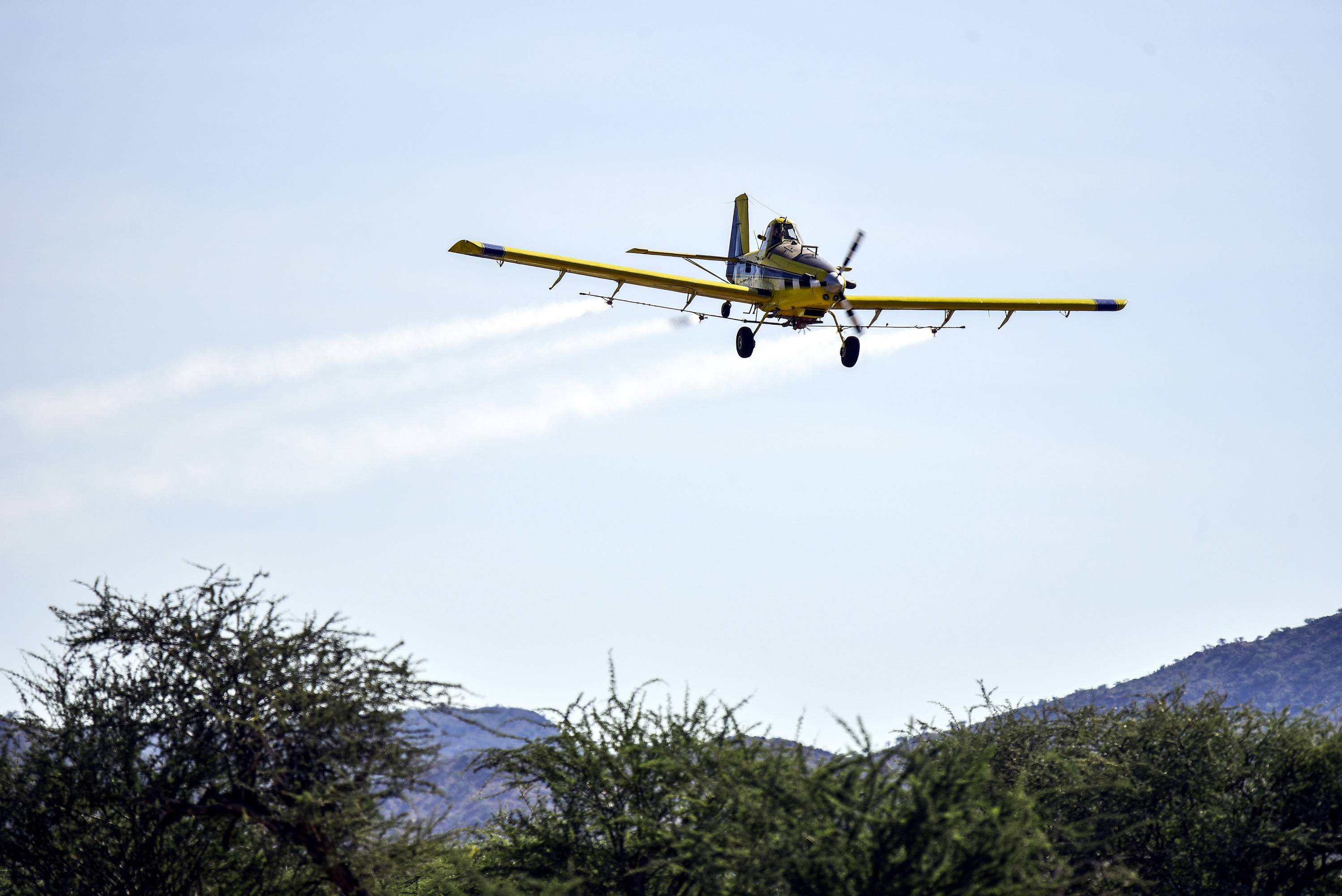
Airplane spraying quelea bird roosting sites with fenthion
Mechanical destruction
Quelea swarms roost in one area in between flights. This gives an opportunity to cull a large portion of the birds using various methods of destruction. Botswana and South Africa have carried out large scale eradication campaigns in the breeding sites using dynamite or diesel/petrol bombs. Others have tried destroying breeding and roosting sites with tractor mounted brushing equipment.
However, as mentioned earlier, in Zimbabwe quelea birds roost in national parks. Therefore, this control mechanism becomes problematic as it also destroys the environment and habitat of other birds and animals.

Quelea bird roosting sites can span many square kilometres. Most of the large scale control methods use this opportunity to cull them when they are sleeping or resting.
Pesticides - Fenthion
Large scale spraying of a chemical called Fenthion is currently the favoured and effective method of control. Using ground and airborne means, the quelea swarms are sprayed while in their roosting sites.
However, fenthion is toxic to non-target species including rodents, fish and other birds. It has been banned in many countries and is a controlled substance in Zimbabwe that is only handled by the Migratory Pests and Biosecurity Control Department.
The other challenge with using Fenthion is the possibility that it is introduced into people as they consume the birds. Although public information campaigns are conducted on the dangers of eating the sprayed birds, communities still rush to harvest them to eat and sell after each spraying campaign.
The Rotterdam Convention has, on multiple occasions, discussed listing the pesticide on the Annex III of the Convention - a list of pesticides and industrial chemicals that have been banned or severely restricted for health or environmental reasons. But each time consensus has not been reached due to lack of alternatives.
There is still a possibility that the chemical will finally be added to the Annex III list soon. If that happens, then Zimbabwe and many other African countries that rely on the pesticide will be left without an option for large scale control of quelea birds.

An airplane prepares to take off for for a spraying operation
Pesticides - Cyanophos
Cyanophos is an alternative to Fenthion that is less toxic to mammals and non-target birds. However, the lower toxicity means it takes longer to kill and can be carried over a wide geographic area as the birds fly. This could result in more secondary poisoning of carnivores that eat the birds. Interestingly, Cyanophos is classified as an extremely hazardous substance in the United States of America and European Union.
Bird Repellents
Some chemicals can be sprayed on the grain to give it a bitter taste to the bird and discourage it from eating the cereals. Other variants weaken the birds and make it easier to kill them using traditional means. Unfortunately, so far these have not been popular with farmers as they wash away when it rains and require repeated application. In addition, repellents are only a deterrence and do not reduce the quelea populations.
Natural Predators
Another more sustainable option being tested in Botswana is the use predators to chase away the birds. Between 2019 – 2021 FAO Southern Africa launched a $300 000 the project targeting Zimbabwe, Zambia and Mozambique aimed at testing the use of falcons to scare quelea from fields. A similar two-year programme in Botswana demonstrated that falcons could be trained to chase away quelea birds. However, falcons work at small scale and might not adequately substitute large-scale mechanisms like spraying.
The falcon programme was disrupted by the COVID-19 pandemic in Zimbabwe. There were also challenges with the training rural farmers on handling and keeping the birds.
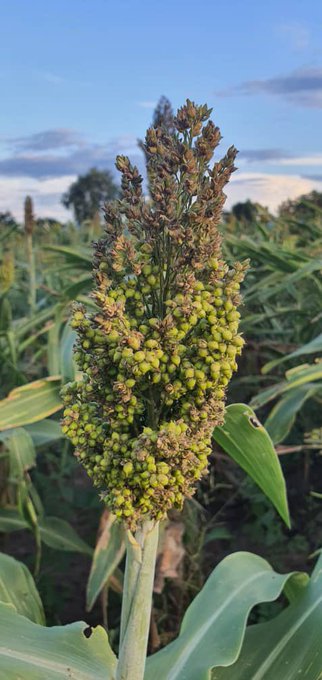
‘Self defense’ grain
Certain of varieties of grain can provide a defence for themselves against quelea birds. For example, some sorghum variants have a high concentration of a chemical called cyanogenic glycoside dhurrin, which is avoided by the bird. In Zimbabwe, queleas prefer white sorghum over red sorghum. Farmers who grow the red variety are relatively safer when quelea swarm attack. However, it is white sorghum that fetches significantly higher prices on the market for farmers. Early maturing varieties can also be promoted to lessen time in the field, therefore less exposure to the birds.
Other alternatives
A study on alternatives to fenthion for quelea bird control comprehensively looks at some alternative control mechanisms and summarises them here: https://core.ac.uk/download/pdf/161524856.pdf
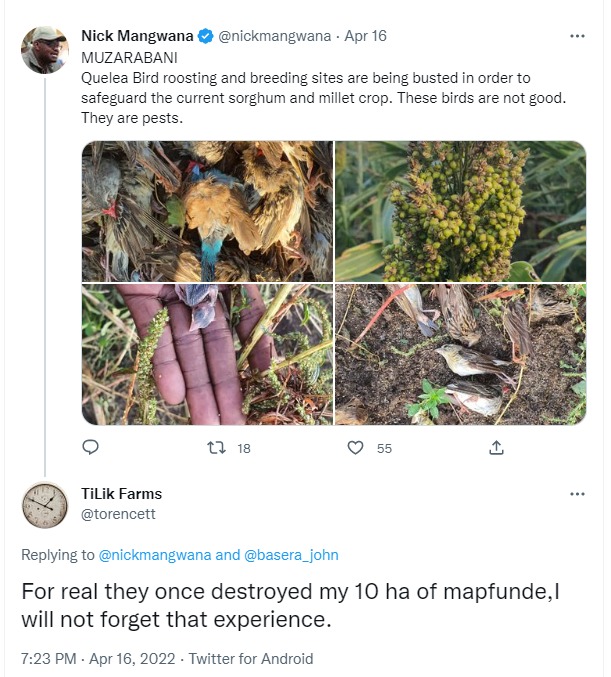
Twitter conversation between the Secretary of Information and a farmer who lost 10 hectares of grain to quelea birds
To kill or deter
Do the control methods necessarily have to kill the quelea birds? Why not promote mechanisms that just deter them from the grain fields and let them find food elsewhere?
As observed over the past two decades, the growth of quelea bird swarms have been growing exponentially due to various reasons, some of them listed in this and the previous blog. The bird is already the most populous on the planet. Some researchers worry that deterring them will only lead to super swarms in the future. Ultimately, the greater the swarm sizes, the more complex it will be to control them.
Emerging technologies
Having conducted a detailed study of the current quelea control methods and understood the current and future impact of not effectively dealing with swarms, the UNDP Accelerator Lab in Zimbabwe sees the urgent need to augment or replace current methods of control. There is an opportunity to use new and emerging technologies at large scale in an environmental and sustainable manner. Below is a summary of some technologies with the potential to tip the balance in the tomorrow war.
Drones (Unmanned Ariel Vehicles)
Already drones are being used during quelea spraying campaigns in Zimbabwe by the Ministry of Agriculture as they are time and cost effective. However, the lab sees opportunity in exploring the use of swarming drones to control quelea birds. For example, drones mimicking eagle sounds could be used to scare the birds away or drive swarms towards a desired direction where other large scale control means can be deployed.
Use of lasers
Lasers have been proven to be effective in deterring pigeons and ducks in parking lots and parks. A similar approach could be adopted to deal with quelea birds. Laser bird repellers work by casting random combinations of red and green lasers which the birds perceive as a physical danger, causing them to fly away. The random patterns and light colours stop the birds from getting used to the system.
Modelling and forecasting
Since quelea swarms are controlled by the availability of food, it is possible to forecast their outbreaks. A quelea forecasting system with up to 95% accuracy ran from 2001 – 2009 and was discontinued when funding ceased. Revisiting the concept with the advances made in forecasting technology since 2009 could act as an early warning system for quelea control allowing for a coordinated response before outbreaks occur.
The Accelerator Lab way
Dealing with quelea birds is a complex challenge that overlaps multiple issues including human wildlife conflict, food security, climate change, and environmental protection. A sustainable solution to controlling them will also likely be a combination of multiple technologies and existing methods. For example, a forecasting data is used to design an appropriate response such as machine learning controlled drone swarms or lasers. Or a GPS guided laser system that directs quelea birds towards a net capture mechanism. Whatever the solution, it will need to be easily deployable, scalable, and sustainable.
The Accelerator is embarking on a solution mapping and testing journey to explore these moon-shot solutions.
We are looking to team up with partner private and public partners. If you think you have an idea on how we can win this tomorrow war, get in touch. We can’t wait to hear from you!
Thousands of tons of grain could be saved from destruction by quelea birds and change the course of Africa’s future in the face of climate change.

 Locations
Locations